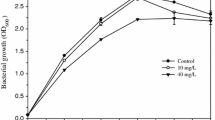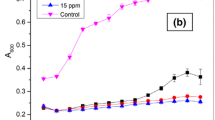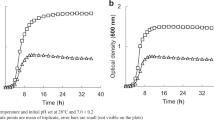Abstract
Studies of Cr(VI) toxicity are generally performed using chromate salts in solution, both when studying the effects on prokaryotes and eukaryotes. Some studies on human carcinogenesis and toxicology on bacteria were done using dichromate, but comparison with chromate was never reported before, and dichromate existence was never taken into consideration and usually overlooked. This paper studied comparatively the effect of dichromate and chromate on the physiology of Ochrobactrum tritici strain 5bvl1, a highly Cr(VI)-resistant and reducing microorganism. This study demonstrated that the addition of chromate or dichromate sodium salts to growth medium at neutral pH ended-up in two different solutions with a different balance of chemical species. Cr(VI) was toxic to O. tritici strain 5bvl1, as clearly shown on growth, reduction, respiration, glucose accumulation assays and by comparing cell morphology. Moreover, the addition of sodium dichromate was always more toxic to cells when compared to chromate and achieved a higher inhibition of every parameter studied. The toxicity differences between the two Cr(VI) oxyanions indicate the possibility of a different impact of Cr(VI) contamination on the environment. This may be of major importance, considering the slight acidity of most of the arable lands which favours the presence of dichromate, the more toxic species.









Similar content being viewed by others
References
Ackerley DF, Barak Y, Lynch SV, Curtin J, Matin A (2006) Effect of chromate stress on Escherichia coli K-12. J Bacteriol 188:3371–3381
American Public Health Association (1998) Metals, part 3000. In: Clesceri LS, Greenberg AE, Eaton AD (eds) Standard methods for the determination of water and wastewater, 20th edn. American Public Health Association, Washington, DC, pp 65–68
Branco R, Alpoim MC, Morais PV (2004) Ochrobatrum tritici strain 5bvl1—characterization of a Cr(VI)-resistant and Cr(VI)-reducing strain. Can J Microbiol 50:697–703
Branco R, Chung AP, Johnston T, Gurel V, Morais PV, Zhitkovich A (2008) The chromate-inducible chrBACF operon from the transposable element TnOtChr confers resistance to chromium(VI) and superoxide. J Bacteriol 190:6996–7003
Calheiros R, Machado NFL, Fiúza SM, Gaspar A, Garrido J, Milhazes N, Borges F, Marques MPM (2008) Antioxidant phenolic esters with potential anticancer activity: a Raman spectroscopy study. J Raman Spectrosc 39:95–107
Camargo FAO, Okeke BC, Bento FM, Frankenberger WT (2003) In vitro reduction of hexavalent chromium by a cell-free extract of Bacillus sp. ES 29 stimulated by Cu2+. Appl Microbiol Biotechnol 62:569–573
Campos-Garcia J, Martinez-Cadena G, Alvarez-González R, Cervantes C (1997) Purification and partial characterization of a chromate reductase from Bacillus. Rev Latinoam Microbiol 39:73–81
Cervantes C, Campos-Garcia J (2007) Reduction and efflux of chromate by bacteria. In: Nies DH, Silver S (eds) Molecular microbiology of heavy metals. Microbiol Monogr, vol 6. Springer, Berlin, pp 407–419
Chardin B, Giudici-Orticoni M-T, De Luca G, Guigliarelli B, Bruschi M (2003) Hydrogenases in sulfate-reducing bacteria function as chromium reductase. Appl Microbiol Biotechnol 63:315–321
Chourey K, Wei W, Wan X-F, Thompson DK (2008) Transcriptome analysis reveals response regulator SO2426-mediated gene expression in Shewanella oneidensis MR-1 under chromate challenge. BMC Genomics 9:395
Codd R, Dillon CT, Levina A, Lay PA (2001) Studies on the genotoxicity of chromium: from the test tube to the cell. Coordin Chem Rev 216–217:537–582
Cruywagen JJ, Heyns JBB, Rohwer EA (1998) New spectrophotometric evidence for the existence of HCrO4. Polyhedron 17:1741–1746
Dartsch PC, Hildenbrand S, Kimmel R, Schmahl FW (1998) Investigations on the nephrotoxicity and hepatotoxicity of trivalent and hexavalent chromium compounds. Int Arch Occup Environ Health 71:40–45
Daulton TL, Little BJ, Lowe K, Jones-Meehan J (2001) In situ environmental cell—transmission electron microscopy study of microbial reduction of chromium(VI) using electron energy loss spectroscopy. Microsc Microanal 7:470–485
Direcção Geral do Ambiente (2000) Solos. In: Direcção Geral do Ambiente (ed) Relatório do Estado do Ambiente 1999. Agência Portuguesa do Ambiente, Lisbon, Portugal, pp 221–224
Elangovan R, Abhipsa S, Rohit B, Ligy P, Chandraraj K (2006) Reduction of Cr(VI) by a Bacillus sp. Biotechnol Lett 28:247–252
Estabrook RW (1967) Mitochondrial respiratory control and the polarography measurement of ADP/O ratios. Methods Enzymol 10:41–47
Francisco R, Alpoim MC, Morais PV (2002) Diversity of chromium-resistant and—reducing bacteria in a chromium-contaminated activated sludge. J Appl Microbiol 92:837–843
Francisco R, Kanouté AL, Alpoim MC, Morais PV (2005) Comparative study of Cr(VI) reduction ability of Ochrobactrum tritici strain 5bvl1 and Microbacterium sp. strain 3a. J Biotechnol 118(Suppl.):S163–S164
Fredrickson JK, Kostandarithes HM, Li SW, Plymale AE, Daly MJ (2000) Reduction of Fe(III), Cr(VI), U(VI), and Tc(VII) by Deinococcus radiodurans R1. Appl Environ Microbiol 66:2006–2011
Hughes K, Meek ME, Seed LJ, Schedden J (1994) Chromium and its compounds—evaluation of risks to health from environmental exposure in Canada. J Environ Sci Health C Environ Carcinog Ecotoxicol Rev 12:237–255
Huser J, Rechenmacher CE, Blatter LA (1998) Imaging the permeability pore transition in single mitochondria. Biophys J 74:2129–2137
Konopka A, Zakharova T (1999) Quantification of bacterial lead resistance via activity assays. J Microbiol Methods 37:17–22
Kwak YH, Lee DS, Kim HB (2003) Vibrio harveyi nitroreductase is also a chromate reductase. Appl Environ Microbiol 69:4390–4395
Lee AJ, Hodges NJ, Chipman JK (2005) Interindividual variability in response to sodium dichromate-induced oxidative DNA damage: role of the Ser326Cys polymorphism in the DNA-repair protein of 8-Oxo-7, 8-Dihydro-2′-Deoxyguanosine DNA Glycosylase 1. Cancer Epidemiol Biomar Prevent 14:497–505
Li B, Pan D, Zheng J, Cheng Y, Ma X, Huang F, Lin Z (2008) Microscopic investigations of the Cr(VI) uptake mechanism of living Ochrobactrum anthropi. Langmuir 24:9630–9635
Llovera S, Bonet R, Simon-Pujol MD, Congregado F (1993) Chromate reduction by resting cells of Agrobacterium radiobacter EPS-916. Appl Environ Microbiol 59:3516–3518
McLean J, Beveridge TJ (2001) Chromate reduction by Pseudomonad isolated from a site contaminated with chromated copper arsenate. Appl Environ Microbiol 67:1076–1084
Messer J, Reynolds M, Stoddard L, Zhitkovich A (2006) Causes of DNA single-strand breaks during reduction of chromate by glutathione in vitro and in cells. Free Radic Biol Med 40:1981–1992
Mounir M, Lorenzo J, Ferrer M, Prieto MJ, Rossell O, Avilès FX, Moreno V (2007) DNA interaction and antiproliferative behavior of the water soluble platinum supramolecular squares [(en)Pt(N–N)]4(NO3)8 (en = ethylenediamine, N–N = 4,4′-bipyridine or 1,4-bis(4-pyridyl)tetrafluorobenzene). J Inorg Biochem 101:660–666
Nielsen P, Fritze D, Priest FG (1995) Phenetic diversity of alkaliphilic Bacillus strains: proposal for nine new species. Microbiology 141:1745–1761
Nies DH, Rehbein G, Hoffmann T, Baumann C, Grosse C (2006) Paralogs of genes encoding metal resistance proteins in Cupriavidus metallidurans strain CH34. Mol Microbiol Biotechnol 11:82–93
Park CH, Keyhan M, Wielinga B, Fendorf S, Matin A (2000) Purification to homogeneity and characterization of a novel Pseudomonas putida chromate reductase. Appl Environ Microbiol 66:1788–1795
Ramirez-Diaz MI, Diaz-Perez C, Vargas E, Riveros-Rosas H, Campos-Garcia J, Cervantes C (2008) Mechanisms of bacterial resistance to chromium compounds. Biometals 21:321–332
Ramsey JD, Xia L, Kendig MW, McCreery RL (2001) Raman spectroscopic analysis of the speciation of dilute chromate solutions. Corros Sci 43:1557–1572
Reynolds MF, Peterson-Roth EC, Jonhston T, Gurel VM, Menard HL, Zhitkovich A (2009) Rapid DNA double-strand breaks resulting from processing of Cr-DNA crosslinks by both MutS dimers. Cancer Res 69:1071–1079
Shen H, Wang Y-T (1993) Characterization of enzymatic reduction of hexavalent chromium by Escherichia coli ATCC 33456. Appl Environ Microbiol 59:3771–3777
Wang PC, Mori J, Toda K, Ohtake H (1990) Membrane-associated chromate reductase activity from Enterobacter cloacae. J Bacteriol 172:1670–1672
World Health Association (1993) Guidelines for drinking-water quality—Chromium. In: World Health Association (ed) Guidelines for drinking-water quality (vol 1, Recomendations). World Health Association, Geneva, Switzerland, pp 45–46
Acknowledgments
This research was founded by Fundação para a Ciência e Tecnologia (FCT), Portugal, under PPCDT/AMB/60909/2006 project. Romeu Francisco was supported by PhD grants from FCT. We would also like to thank professor Alexandre Lobo da Cunha, of Institute of Biomedical Sciences Abel Salazar.of Porto, Portugal, for his help in the preparation of cell samples for electron microscopy. TMAFM was performed at University of Barcelona, Department of Inorganic Chemistry, Spain, by professor Virtudes Moreno.
Author information
Authors and Affiliations
Corresponding author
Rights and permissions
About this article
Cite this article
Francisco, R., Moreno, A. & Morais, P.V. Different physiological responses to chromate and dichromate in the chromium resistant and reducing strain Ochrobactrum tritici 5bvl1. Biometals 23, 713–725 (2010). https://doi.org/10.1007/s10534-010-9338-9
Received:
Accepted:
Published:
Issue Date:
DOI: https://doi.org/10.1007/s10534-010-9338-9




